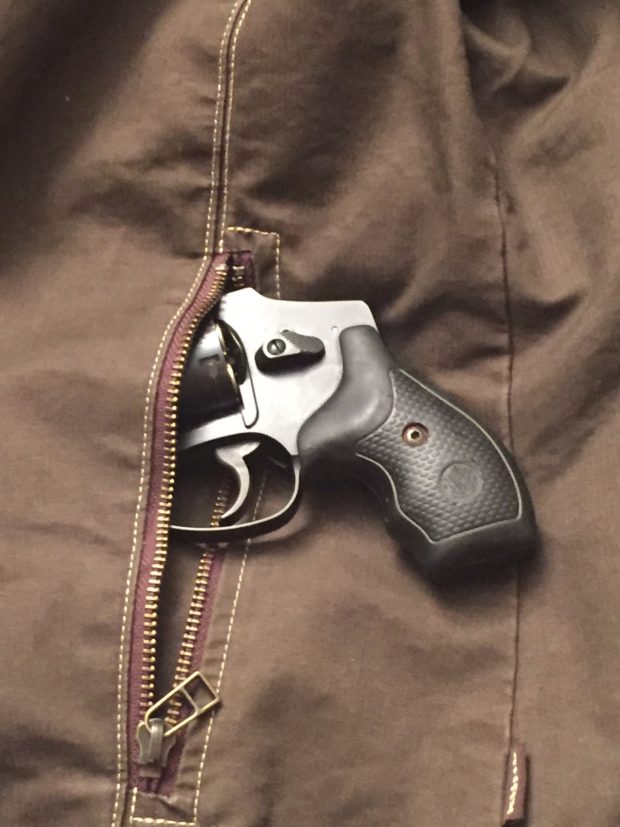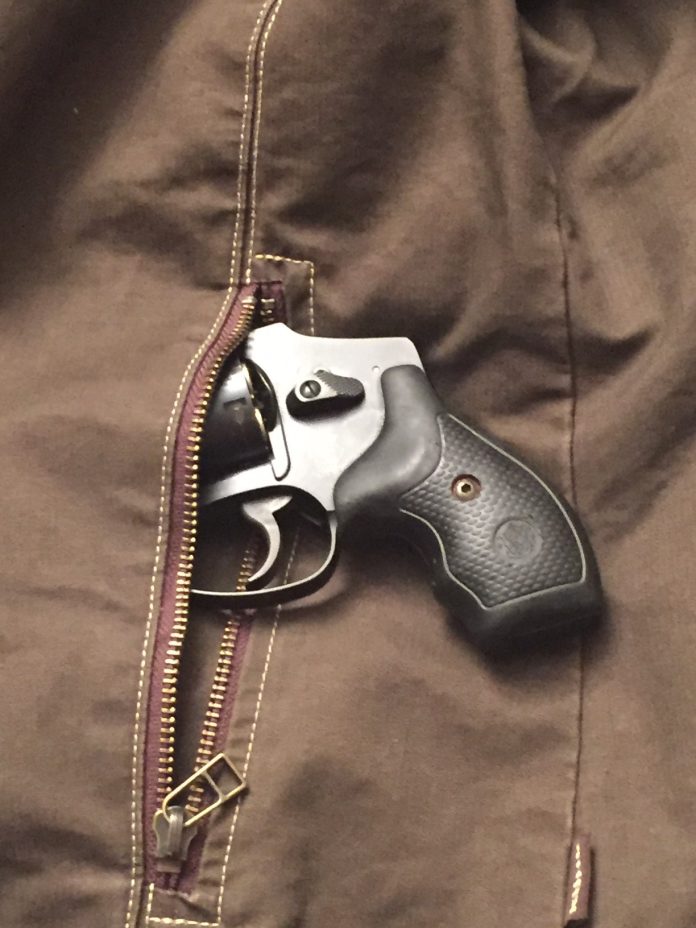The weather is becoming colder. Many of you folks will soon be wearing large winter coats if you aren’t already. Have you ever tried to draw your defensive firearm while you are bundled up in a winter parka? Sometimes it’s harder than one might think.
A friend once asked me for some winter coat carry advice. He normally carried a 9mm Glock 19 inside the waistband. Living in Minnesota, he found access to his Glock to be rather difficult when the gun was covered up by his heavy winter coat. My friend wanted to supplement his Glock with a smaller pistol carried in his outside coat pocket for quicker access in cold temperatures. Which pistol would be the best choice?
That’s a good question. Before I moved to Texas, I braved Ohio’s winters regularly carrying a revolver in an outside coat pocket. When the snow accumulated enough to cover up my ankle gun if I stepped in a snow drift, I carried my police backup gun in my outer coat pocket. I have a few thoughts on the subject.
Revolver vs Auto Pistol?
Most of you carry autopistols for defensive purposes these days, but they don’t make very good pocket guns. If you have to fire the gun from inside the pocket, there is a good chance that the reciprocating slide will catch on some part of the pocket and cause a malfunction. Revolvers are less likely to jam.
While almost any revolver will be a decent choice, a short barrelled revolver with a shrouded hammer or hammerless design is probably best. There is a small chance that a gun with an exposed hammer could catch in the coat pocket when attempting to draw the weapon. There is also a significant chance that a piece of clothing material could slip down in between the hammer and the frame during the firing cycle as well.
If you want to see how this works, check out my article titled Shooting Through Bags and Purses. In the second video from the article, I shot a revolver with an exposed hammer through a purse and the hammer snagged on some material as I fired. The same thing happens when firing from a coat pocket.
If you are going to pocket carry, make it a revolver (ideally a hammerless revolver).
What caliber?
There are quite a few defensive cartridge options. Most will work, but there are a few special considerations that must be considered before choosing a pocket pistol caliber. The first consideration is recoil control. When firing from the pocket, you are forced to shoot one-handed. If you have any difficulty controlling recoil when shooting your gun with two hands, the issue will be even more pronounced when firing one-handed from the pocket. For me, that eliminates the .357 magnum loads from consideration.
If we take the .357 out of the equation, other currently produced snub revolver cartridges are the 9mm, .38 special, .32 magnum/.327 Federal, .22 magnum, and .22 long rifle. Looking at these options brings us to an additional pocket-specific caliber issue. That issue is muzzle blast. If your gun shoots a big flaming fireball every time you pull the trigger, you may have some problems shooting from the pocket. I’ve had several students in classes actually set their coats on fire from excessive muzzle flash when shooting from a pocket. Not good.
Of our remaining cartridges, the 9mm, .327 mag and the .22 magnum tend to have the most muzzle flash. I would generally avoid using those rounds in a pocket-carried gun unless you are using cartridges that are loaded with a special low-flash gunpowder. While setting a small fire in your coat pocket isn’t a big deal in the context of getting killed by an attacker, I still think it’s likely to cause a distraction at the worst possible moment. If I’m in life-threatening danger, I want to devote all my mental energy to solving the problem at hand instead of worrying about getting burned by a smoldering coat that has been set ablaze by my own pistol.
If you read enough history books, you’ll see numerous anecdotes of Old West gunfighters setting clothing on fire with cap and ball revolvers fired from outer coat pockets. In several of those events, the gunmen were seriously distracted during the gun fight when their cover garments were set ablaze by the burning black powder. I want to minimize such distractions if at all possible.
If we want a gun with minimal muzzle blast, we are left with the .22 long rifle and the .38 special for contenders as the pocket carry champion. I think either weapon could be a good option. If one is exceptionally recoil sensitive, the .22 might be the better choice. Remember, you’ll likely be firing the gun one-handed. The .22 might also be a good option if capacity is an issue. Revolvers are slow to reload. If you are only carrying one gun, having eight rounds is better than having five rounds. If this gun is intended to be a backup to a waistband-carried primary weapon, capacity isn’t as important. If my pocket gun was backed up by a Glock 19, I’d choose the .38 over the .22 for better terminal ballistic performance.
Weight is a big issue for pocket carry
I spent a few weeks carrying a whole bunch of different snub nosed revolvers in my outside coat pocket. I was amazed at how much the weight of the gun made a difference in printing and carrying comfort. If the coat was unbuttoned or unzipped, a heavier gun became very obvious when carried in an outer coat pocket. The heavy gun drags one side of the coat down a couple inches lower than the side without the gun.
I weighed all of the guns under consideration on a postal scale. I weighed them while fully loaded with defensive ammunition. I had the exact same grips (Uncle Mike’s rubber boot grips) on all the Smith and Wesson revolvers for consistency purposes. Here are my results:
Smith and Wesson 43C .22 long rifle loaded with 8 rounds of 29 grain Federal Punch ammo- 12.2 ounces
Smith and Wesson 342 .38 special loaded with 5 rounds 130 grain Winchester Ranger ammo- 14.0 ounces
Smith and Wesson 351 .22 magnum loaded with 7 rounds of 45 grain Hornady Critical Defense ammo- 15.4 ounces
Ruger LCR .38 special loaded with five rounds of 130 grain Winchester Ranger ammo- 15.8 ounces
Smith and Wesson 442 .38 special loaded with 5 rounds 130 grain Winchester Ranger ammo-18.3 ounces
Colt Cobra .38 special loaded with 6 rounds 130 grain Winchester Ranger ammo-18.8 ounces
Smith and Wesson 36 .38 special loaded with 5 rounds 130 grain Winchester Ranger ammo-22.3 ounces
Smith and Wesson 12 .38 special loaded with 6 rounds 130 grain Winchester Ranger ammo- 24.3 ounces
While carrying these guns, I found a tremendous difference between the aluminum frame guns and the steel frame guns when I carried them in an outside coat pocket. Obviously, every person and every coat is different, but I found that the guns weighing more than 20 ounces were consistently harder to conceal.
What’s the best choice?
Factoring in all the variables of recoil, capacity, muzzle flash, and weight, I think the best choice for coat pocket carry is either the Smith and Wesson airweight 442/642 or the Ruger LCR. Both are great choices. The heavier guns and the magnum calibers are noticeably less useful for coat pocket carry. The super light .38s (like the 342) are nice to carry, but recoil is much harder to control. In my estimation the airweight style .38s are the best compromise for pocket carry.
I recommend the Speer Gold Dot 135 grain short barrel hollowpoint or the 120 grain Federal Punch as the best defensive load in a steel-framed gun. If the recoil is too stout with the Gold Dot in an alloy-frame revolver, the plain old 148 grain target wadcutter round creates a full caliber hole and adequate penetration in flesh. It also has very low recoil. That’s the defensive round I carry in my Smith 342 and 442 pocket revolvers.
I prefer the Georgia Arms wadcutter load, but they recently had a fire in their factory and production has been delayed. My friend Mark Fricke has done extensive ballistic tests on every .38 full wadcutter load on the market. He believes that a .38 wadcutter traveling between 700 and 750 feet per second out of the snub offers the best balance of low recoil and terminal performance. If you can’t get the Georgia Arms load, pick any other brand as long as it chronographs in excess of 700 feet per second.

If you choose a .22 revolver, I would suggest either the 29 grain Federal Punch or the 40 grain CCI Velocitor as the best defensive carry rounds.
If you are carrying in a coat pocket, please use a pocket holster. There are lots of good ones on the market. My favorites are the DeSantis Nemesis or Superfly. Both holsters are inexpensive and hold up well. If you like leather, I highly recommend my friend Rob Leahy’s Simply Rugged “Force Option” pocket holster.

A great leather pocket holster
My last suggestion is that if you choose to carry in a coat pocket holster, you should actually try shooting through the pocket at the range. Pick up a few cheap coats at a thrift store and practice shooting the gun from your pocket. It’s a worthwhile training exercise.










